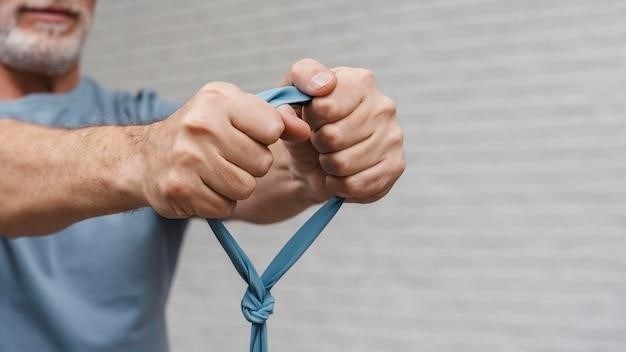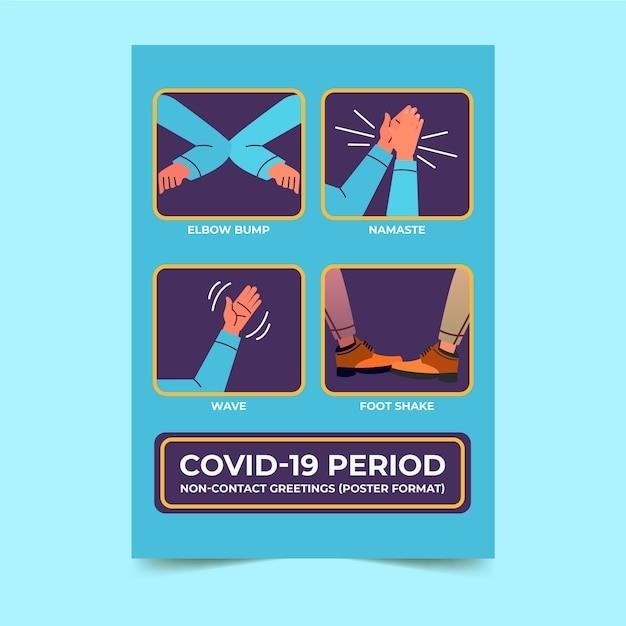Hand Exercises for Stroke Patients⁚ A Comprehensive Guide
This comprehensive guide explores the benefits, types, and examples of hand exercises for stroke patients. It also provides tips for performing these exercises, emphasizes the importance of consistency and repetition, outlines safety precautions, and suggests additional resources for further guidance.
Introduction
Stroke, a debilitating condition affecting the brain, often leads to impaired hand function, significantly impacting daily life. This can be frustrating for stroke survivors, limiting their ability to perform simple tasks like dressing, eating, and writing. Fortunately, hand exercises play a crucial role in recovery, promoting strength, dexterity, and overall hand functionality. This guide provides a comprehensive overview of hand exercises specifically designed for stroke patients, offering a roadmap for regaining hand function and improving quality of life.
Benefits of Hand Exercises for Stroke Patients
Hand exercises are not just about regaining physical function; they offer a range of benefits that contribute to a more fulfilling post-stroke life. These exercises help repair brain pathways damaged by stroke, leading to improved strength and range of motion in the affected arm. They enhance the ability to use the affected arm in daily activities, making tasks like dressing, eating, and writing easier. Moreover, these exercises can alleviate pain, improve life satisfaction, and boost overall confidence, empowering stroke survivors to regain independence and actively participate in their recovery journey.
Types of Hand Exercises
Hand exercises for stroke patients are categorized into three main types, each targeting specific aspects of hand function⁚ Range of Motion exercises focus on improving flexibility and restoring the full movement of the hand and fingers. Strength Training exercises aim to build muscle strength and endurance, enabling greater control and power in hand movements. Fine Motor Skills exercises hone dexterity and coordination, essential for everyday tasks like buttoning, writing, and using utensils. By incorporating these different types of exercises into a comprehensive program, stroke patients can address various functional limitations and work towards regaining optimal hand function.
Range of Motion Exercises
Range of motion exercises are crucial for stroke patients as they help to maintain flexibility and prevent stiffness in the affected hand. These exercises involve gently moving the hand and fingers through their full range of motion, promoting blood flow and increasing awareness of the affected limb. Examples include making a fist and then extending the fingers, moving the wrist up and down, and rotating the hand from side to side; These exercises should be performed slowly and without forcing any movements. Stopping if any pain is experienced is essential to avoid further injury. Regularly performing these exercises can help to prevent contractures, a condition that can severely limit hand function.
Strength Training Exercises
Strength training exercises play a vital role in hand rehabilitation after a stroke. These exercises aim to enhance the strength of the muscles in the hand, wrist, and forearm, improving grip and pinch strength. They can involve using resistance bands, weights, or even everyday objects like a tennis ball or a water bottle. Examples include squeezing a rubber ball, lifting weights with the affected hand, or performing finger curls using a resistance band. It’s crucial to start with light resistance and gradually increase the weight or tension as the hand strengthens. Remember to consult with a physical therapist or occupational therapist for personalized guidance and proper form, ensuring safe and effective strength training.
Fine Motor Skills Exercises
Fine motor skills exercises are critical for stroke patients to regain dexterity and coordination in their hands. These exercises focus on improving the ability to perform precise movements with the fingers and hand, essential for everyday activities like buttoning clothes, writing, and eating. Examples include picking up small objects, using tweezers to pick up beads, or playing with building blocks. These activities help improve hand-eye coordination, finger dexterity, and precision grip. Regular practice of these exercises can significantly enhance the ability to perform daily tasks with greater independence and ease. Remember to tailor the exercises to the individual’s abilities and gradually increase the complexity as they progress.
Exercise Examples
This section provides specific examples of hand exercises that can be incorporated into a stroke recovery program. These exercises target different aspects of hand function, from improving range of motion to strengthening grip and pinch strength. It’s important to note that these are just a few examples, and the specific exercises recommended will vary depending on the individual’s needs and abilities. Consult with a physical therapist or occupational therapist for a personalized exercise plan tailored to your specific situation.
Finger Extension and Flexion
Finger extension and flexion exercises are fundamental for regaining hand dexterity. These exercises involve extending and bending each finger individually, focusing on isolating the movement and achieving a full range of motion. Start by extending each finger as far as possible, then gently curl it back into a fist. Repeat this movement for each finger, focusing on smooth and controlled motions. You can perform this exercise while sitting or lying down, with your hand resting on a flat surface. Regularly performing these exercises helps improve finger mobility, coordination, and strength, which are crucial for everyday tasks like buttoning clothes, writing, and using utensils.

Wrist Extension and Flexion
Wrist extension and flexion exercises are vital for improving the range of motion and strength in the wrist joint. These exercises involve moving the wrist up and down, focusing on controlled and smooth movements. Start by extending your wrist upwards, as if you are pointing your fingers towards the ceiling. Then, gently bend your wrist downwards, bringing your hand towards your forearm. Repeat this motion, focusing on a full range of movement without forcing or straining the wrist. You can perform these exercises while sitting or standing, with your arm resting on a table or chair for support. Regularly performing these exercises helps improve wrist mobility, coordination, and strength, which are essential for activities like turning doorknobs, holding objects, and using tools.
Grip Strengthening Exercises
Grip strengthening exercises are crucial for stroke patients as they improve hand function and the ability to perform daily tasks. These exercises involve squeezing and holding objects with varying levels of resistance. One simple exercise is to squeeze a soft ball or stress ball repeatedly. You can also use a hand gripper, which provides adjustable resistance levels to challenge your grip strength. Another option is to hold a small object, like a coin or a pen, between your thumb and fingers, and squeeze it tightly. Remember to start with lighter objects and gradually increase the resistance as your grip strength improves. Performing these exercises regularly helps build muscle strength in the hand and forearm, facilitating activities like opening jars, holding utensils, and writing.
Pinch Strengthening Exercises
Pinch strengthening exercises target the muscles involved in precise movements like picking up small objects or using tools. These exercises are essential for improving fine motor skills, which are often affected after a stroke. A common exercise involves picking up small objects, such as beads or marbles, with your thumb and index finger. You can also use clothespins to pinch and release repeatedly. Another effective exercise is to hold a piece of paper between your thumb and index finger and try to pull it out with your other hand. Gradually increase the difficulty by using thicker paper or adding more resistance. These exercises help strengthen the muscles responsible for pinching, improving your ability to handle delicate tasks like buttoning clothes, writing, and eating.
Tips for Performing Hand Exercises
To maximize the benefits of hand exercises and ensure a safe and effective recovery, consider these helpful tips⁚ Start slowly and gradually increase the intensity and duration of your exercises. Listen to your body and stop if you feel any pain. Focus on proper technique and form to avoid strain or injury. Use assistive devices, such as a mirror, to help you visualize and correct your movements. Make exercise a regular part of your routine and incorporate it into your daily activities. Seek guidance from a physical therapist or occupational therapist to ensure you’re performing exercises correctly and safely. Don’t hesitate to ask for help from family members or caregivers to assist with exercises. Remember, patience and consistency are key for successful recovery.

Importance of Consistency and Repetition
Consistency and repetition are crucial for maximizing the benefits of hand exercises after a stroke. Just like any other form of physical therapy, the brain needs time and repeated stimulation to relearn and strengthen the pathways responsible for hand movement. Regular practice helps to improve muscle memory and coordination, making it easier to perform everyday tasks. Aim for a specific number of repetitions for each exercise, such as 10-20, and try to perform them several times a day. Don’t be discouraged if progress seems slow; even small improvements can make a significant difference in your ability to use your hand. Remember, the key is to stay committed and persistent in your efforts.
Safety Precautions
While hand exercises are beneficial, it’s essential to prioritize safety. Listen to your body and stop if you experience any pain or discomfort. Avoid forcing movements, as this can lead to injury. Start slowly and gradually increase the intensity and duration of your exercises as your strength and mobility improve. If you have any pre-existing conditions or concerns, consult with a physical therapist or healthcare professional before starting any new exercise program. They can provide personalized guidance and ensure your safety during rehabilitation.
Additional Resources
For more comprehensive information and guidance on hand exercises for stroke patients, several valuable resources are available. Websites like Stroke Recovery Association of Manitoba provide downloadable PDFs with exercise routines covering various body areas, including hands. Additionally, “Assisting hand and arm recovery (after a stroke)” from the NHS provides helpful insights. Online platforms like Romatem offer robotic assisted walking and physical therapy programs for stroke recovery. These resources can enhance your understanding of hand exercises and facilitate your rehabilitation journey.
Hand exercises play a crucial role in the recovery of stroke patients, improving hand function, strength, and dexterity. By incorporating these exercises into your rehabilitation routine, you can significantly enhance your ability to perform daily activities. Remember to consult with your healthcare professional to determine the most appropriate exercises for your individual needs and to ensure safety. With dedication, consistency, and proper guidance, you can regain hand function and live a fulfilling life after stroke.



